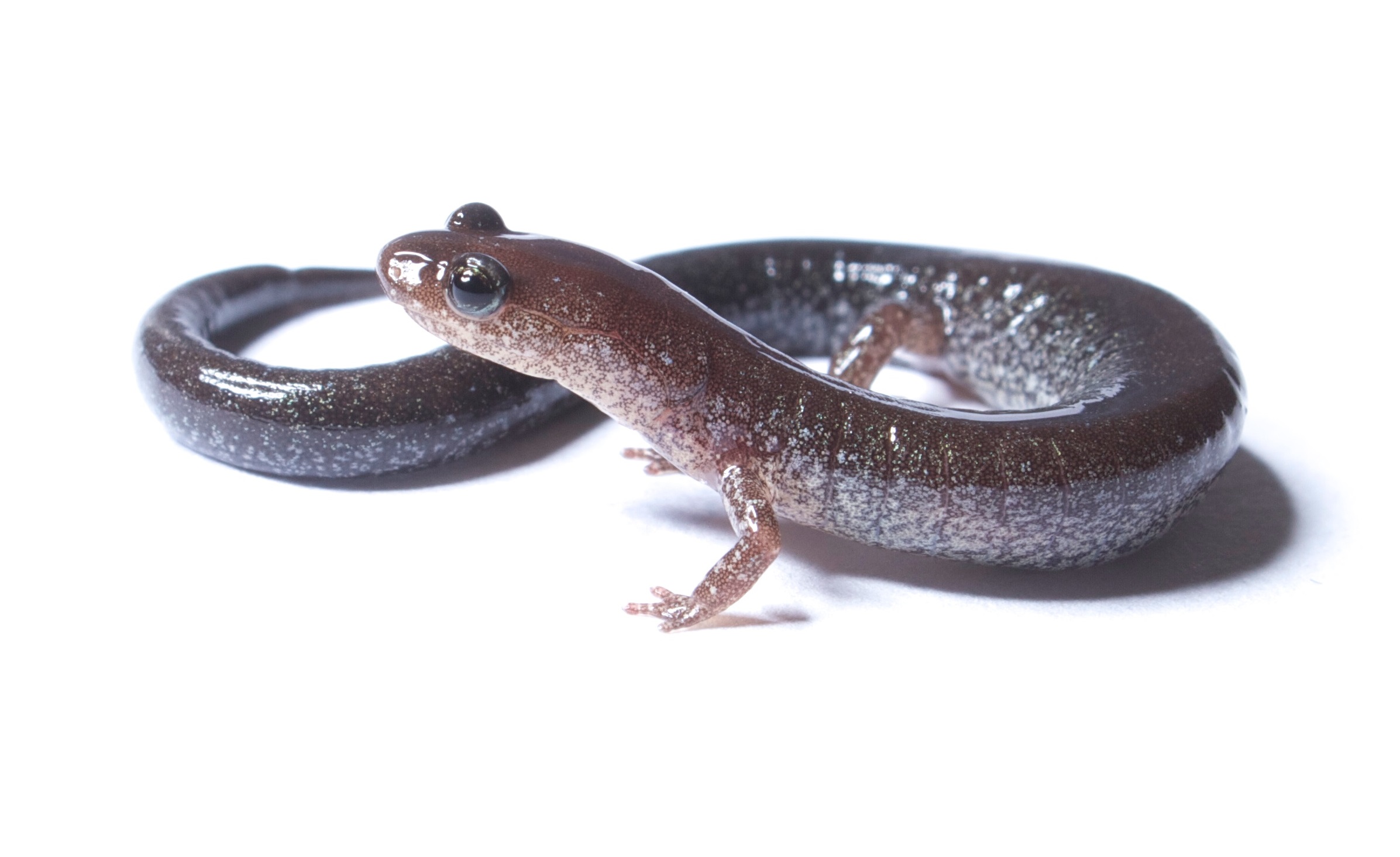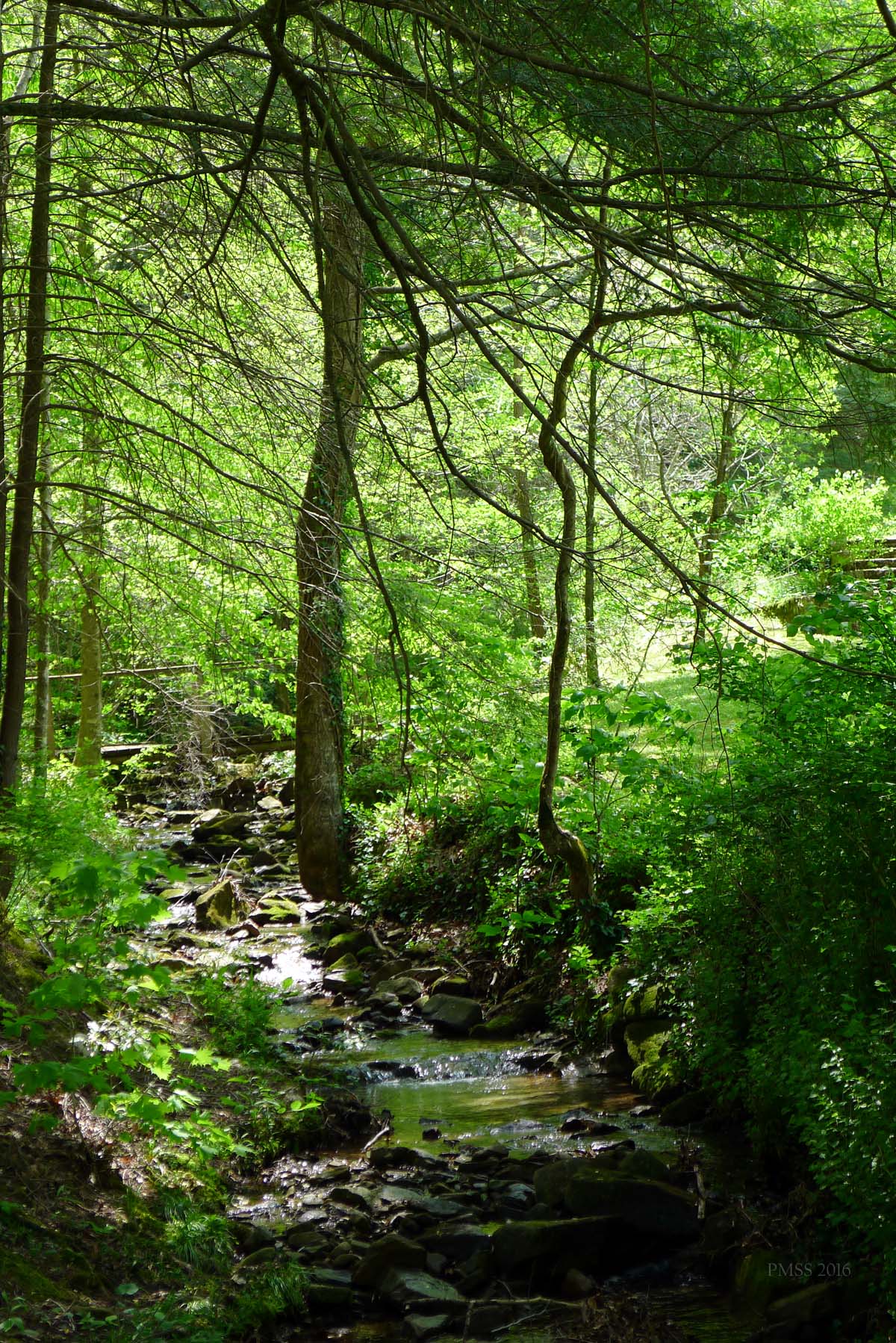Pine Mountain Settlement School
Environmental Education
SALAMANDERS at Pine Mountain Settlement School

[Brian Gratwicke [CC BY 2.0 (https://creativecommons.org/licenses/by/2.0)] Wikimedia Commons
TAGS: salamanders, green salamander, Pine Mountain Settlement School, Clifford H. Pope, Harlan County, Kentucky, Plethdons, Plethodon Aneides aeneus, Greasy Creek, Limestone Creek, 1928 , ecological life histories, chestnut trees, ecological history, eggs, hibernation, salamander aggression, red-backed salamanders
The salamanders of Pine Mountain Settlement School are some of its most fascinating residents and like the School, they have an engaging history- one that has captured the attention of herpetologists through the years.
In 1928, Clifford H. Pope a herpetologist and conservationist with the American Museum of Natural History, engaged in a field study of salamanders from the mountains of North Carolina to the Cumberland Plateau of Kentucky. His study was far-ranging, and one segment took place at Pine Mountain Settlement School in Harlan County, Kentucky. Funded by the Douglas Burden Research Fund, Pope was at the School for the purpose of a field study to determine the relationships of four species of the genus Plethodon — P. glutinosus, P. shermani, P. jordani, and P. metcalfi. The focus of Pope’s work at Pine Mountain was a species within the Plethodontidae family, known as Aneides aeneus. Also called the “green salamander,” it is today a rare lungless salamander seldom encountered in the region.
The Plethodon salamander genus

[Brian Gratwicke [CC BY 2.0 (https://creativecommons.org/licenses/by/2.0) ]Wikipedia
In his published research in American Museum Novitates, No. 306, April 14, 1928, he noted the hospitality he received at the School from “Mrs. Ethel de Long Zande and her colleagues who made me feel very much at home while collecting …” Pope was at Pine Mountain Settlement for five days, from July 20th until the 25th and a return for one day on the 28th. He was assisted in his search for salamanders by a Pine Mountain student, Evans Compton. Evans, a thirteen-year-old, was familiar with the local terrain and acted as an assistant in the collection of the salamanders.
The salamander search is described in Clifford Pope’s notes from his field diary:
July 20. We hunted for part of the afternoon on the School grounds just below the reservfoir in damp, thick woods and found one specien inside of a large, decayed log.
July 21. during the morning we hunted in the forest along the Laden Trail, a wagon road that crosses Pine Mountain about a mile southwest of the School, and found five specimens (A.M.N.H. Nos. 25583-25587) as follows:
Pope, p. 8
(a) a small one under the very loose bark of a solid log lying beside the road. Only a little bark remained on the log;
(b) two small ones under the bark of a limb of a large, prostrate water oak. The log was solid and the specimens were about five feet above the ground;
(c) one more under the very loose bark of a large, prostrate, solid, chestnut log lying by the road;
(d) the fifth under the bark of a large, solid, prostrate log embedded in a thicket above the road.
A long unt in the afternoon, along the base of Pine Mountian about a mile northeast of the School, netted only one specimen. It was taken on the edge of a clump of scrub trees under the bark of a solid section of a log lying in a dry, overgrown pasture. The log was exposed to the sun.
July 22. Our morning’s search was fruitless but in the afternoon we found one specimen a mile below the School near Greasy Creek under the bark of a section of a solid water oak lying exposed to the sun in an area devestated by lumbermen and another (A.M.N.H. No. 25589) under the remaining loose bark of a solid, prostrate log also well exposed and lying in the same devestated area.
July 23. Hunting in the forest near the base of Pine Mountain about two miles southwest of the School we found four specimens (A.M.N.H. Nos. 25590-25593), the first two under the loose, decaying bark on the upper side of a huge, prostrate chestnut log and the last under the loose bark of another fallen chestnut tree four or five feet in diameter and not far from the first. Both logs were solid.
The third specimen was found with a batch of fourteen eggs ina prostrate water-oak limb eight feet long and one foot in diameter. The eggs were in a long, shallow cavity one to three inches wide by one deep and near one end of the limb. Much of the bark was missing and the log, though still solid, had a thin layer of decayed wood under the bark where the eggs were found. The cavity was on the side of the log and so the eggs, though virtually suspended, actually rested against the cavity’s bottom or the side of the log.
[Discussion of egg cache]
July 24. During a long half-day’s search we found only one specimen (A.M.N.H. No. 25594). It ws taken in the forest near the base of Pine Mountain some two miles southwest of the School under the very loose, decaying bark of a chestnut limb or small tree barely a foot in diameter leaning against other trees. The salamander was aout five feet above the forest floor.
July 25. It was not until this date that we really found the true habitat of A. aeneus. On this day our first three hours netted twelve specimens and yet we hunted just where we had worked before with little result. Searchig in the forest along the Laden Trail we found:
(a) one at the base of Pine Mountian under the very loose bark of a solid chestnut stump five feet high and ten inches in diameter;
(b) six or seven more not far away under the very loose bark of a solid white walnut limb some twelve fee long and eight inches in diameter lying near a strea in heavy shade with one end propped against small trees and the other resting on the ground;
(c) two more only twenty feet away on a solid, poplar log placed much as the white walnut just described;
(d) two more under the bark of the end branches of a large, solid, basswood log lying in a tangle of weeds and bushes about halfway up Pine Mountain, three to four feet above the forest floor;
(e) two more under the bark of a large, solid chestnut limb lying across a fallen tree; and finally,
(f) four more under the bark of a large, solid, maple log lying near the road about halfway up the mountain.
July 28. In about an hour’s hunting alone in the woods between the School and the reservoir I found five specimens:
(a) two of which were under the loose bark of a slender, solid, chestnut log leaning against some living trees;
(b) one more three feet from the ground under the loose bark of a small, solid stump about four feet high; and finally,
(c) two more, one large and one small four to five feet from the ground under the loose bark of an upright, dead white walnut tree still quite solid and only four to six inches in diameter.
Aneides aeneus,then lives under the loose bark of dead trees.
HABITAT
It is interesting that Pope’s assessment that the habitat of the Aneides aeneus was “under the loose bark of dead trees.” This has been questioned to some degree by more recent articles that suggest the preferred habitat of many green salamanders is indeed in some cases under the loose bark of dead trees in arboreal areas but they are also regularly found in the crevices of rocks. For example, a 1952 article by Robert E. Gordon, a Naturalist at the Highlands Biological Station in North Carolina managed by the Biology Department of the University of Georgia, Athens, he describes crevices to be the preferred habitat. The abstract of Gordon’s study states

” In eastern Kentucky, southwestern Virginia and adjacent portions of Tennessee Aneides aeneus is found to occur in an arboreal or arboreal-rock crevice habitat. Its habitat in all other portions of its range is chiefly rock crevices. The region of arboreal habitat coincides with the undifferentiated mixed mesophytic forest [of Emma Lucy] Braun,] while the rock habitat generally occurs in regions of segregated forests of the mixed mesophytic type. “
Robert E. Gordon. The American Midland Naturalist Vol. 47, No. 3 (May, 1952), pp. 666-701
While Pope focused on the arboreal habitat, he seems to have had some difficulty identifying the names of trees in his field notes and relied on the information given by one of Pine Mountain’s students. He says
Unfortunately, only the popular names of the trees on which my series were taken can be given though these may be relied upon because they were verified by an advanced student of the Settlement School.
12 examples were living in chestnut
8 or 9 examples were living on white walnut
5 examples were living on water oak
4 examples were living on maple
2 examples were living on poplar
2 examples were living on basswood
1 example was living on pine
1 example was living in a decayed logThree additional specimens were found on logs which I failed to identify. The names of at least two of these undetermined logs would be included in the above list. The great number of fallen chestnuts on Pine Mountain mayaccount for their heading the list.
Pope, p. 8
While salamanders have the reputation of being indestructible — going through fire and not being burned, etc., today their numbers are on the decline. In the mid-1970’s the Aneides aeneus that Pope and other found fascinating, started to experience a decline and some call it a population collapse in many of it common ranges. Those who have been monitoring the main 7 green salamander populations have documented “… a 98% decline in relative abundance since 1970.” The decline is remarkably rapid and a novel agent is suspected. Some agents under consideration are climate change, epidemic disease, and over-collecting by pet enthusiasts. [See: Corser, Jeffrey D. “Decline of disjunct green salamander (Aneides aeneus) populations in the southern Appalachians,” Biological Conservation 97(1):119-126.
SEE ALSO:
CLIFFORD POPE Salamanders

